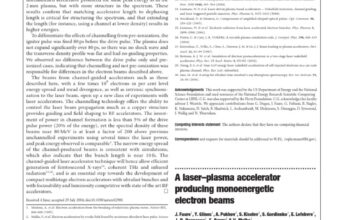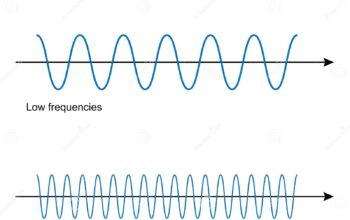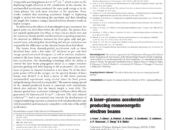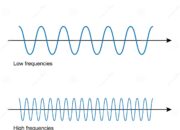In the realm of modern physics, the exploration of light has long captivated the imagination of scientists and philosophers alike. Light, in its manifold manifestations, is not merely an electromagnetic wave; it embodies quantifiable entities known as photons. Each photon serves as a discrete packet of energy, illuminating the intricate interplay of visibility, perception, and detection. Recent advancements in light detection technologies have led to an unprecedented ability to count photons with remarkable precision. This capability heralds a new era in photonics, enabling innovations across a vast array of disciplines, from quantum computing to medical imaging.
Historically, light detection relied on relatively simplistic methodologies that lacked the granularity required to tease apart the subtleties of photon behavior. Traditional detectors, while functional for many routine applications, were often limited in their capacity to quantify individual photons. These devices operated on principles akin to averaging, effectively blurring the fine details of light interactions. As the quest for knowledge deepened, the need for more nuanced instruments became apparent. The contemporary landscape is now replete with sophisticated techniques designed to address this fundamental limitation.
A pivotal breakthrough in photon counting technology emerged with the advent of single-photon avalanche diodes (SPADs). SPADs utilize a distinct mechanism that capitalizes on the photoelectric effect, wherein absorbed photons generate electron-hole pairs that can initiate an avalanche of charge carriers, resulting in detectable current output. This mechanism allows for the detection of individual photons with high efficiency and low noise, thereby significantly enhancing sensitivity. The implications of such advancements extend beyond mere measurement; they invite reevaluation of foundational principles in optics and quantum mechanics.
The capacity to count photons with acute precision has profound implications for quantum optics—the field where the classical and quantum realms converge. Experimental setups utilizing entangled photons have revealed the non-classical nature of light. The phenomenon of quantum superposition suggests that photons can exist in multiple states simultaneously, complicating traditional interpretations of light behavior. The ability to count these photons individually allows researchers to disentangle the complexities of quantum states, leading to innovations in quantum information science and secure communication protocols.
This refinement in photon detection not only permits deeper exploration in quantum phenomena but also enables practical applications in diverse fields. In medical diagnostics, for example, photon-counting techniques are revolutionizing imaging modalities. The emergence of positron emission tomography (PET) scans enriched with photon-counting capabilities results in enhanced resolution and specificity, facilitating early detection of diseases and improving patient outcomes. By leveraging the principles governing photon detection, healthcare practitioners can undertake non-invasive assessments with greater accuracy than ever before.
Moreover, in the domain of astronomy, the elucidation of cosmic phenomena relies heavily on light collection and analysis. Telescopes equipped with advanced photon-counting detectors can dissect the spectral composition of distant celestial bodies. This capability is instrumental in unraveling the mysteries of the universe, allowing astronomers to quantify the age, composition, and movement of stars and galaxies. By counting photons emanating from these celestial sources, scientists gain invaluable insights into the processes governing cosmic evolution.
Photon detection has also made inroads into the burgeoning field of quantum computing. The manipulation of quantum bits, or qubits, is paramount for achieving superlative computational capabilities. Quantum algorithms benefiting from accurate photon counting can perform complex calculations exponentially faster than classical counterparts. This revolutionary approach to computation leverages the inherent probabilistic nature of quantum mechanics and relies heavily on the efficiency of photon detection methods. The intersection of photonics and quantum computing thus cultivates a fertile ground for future technological advancements.
The fascination surrounding photon counting extends beyond scientific inquiry; it resonates with the fundamental quest for understanding the universe. The observation that light can be broken down into individual particles invites deeper philosophical contemplation about the nature of reality. The dual wave-particle nature of light challenges our classical intuitions, compelling us to reconsider the boundaries of perception and knowledge. As philosophers have long debated the ontological status of light, advancements in photon detection illuminate the conversation, presenting new paradigms of thought.
Despite these advancements, a continued pursuit of understanding remains essential. Challenges such as background noise, limited detection efficiency at specific wavelengths, and the integration of photon-counting techniques into existing systems require ongoing research and innovation. The field of photonics is not static; rather, it is a dynamic domain that must adapt to the emerging complexities presented by new scientific discoveries and technological capabilities.
In summary, the ability to count photons with remarkable accuracy represents a paradigm shift in light detection that has reverberated through multiple scientific domains. From enhancing medical imaging to propelling advancements in quantum computing, the implications of these technologies reflect a deeper fascination with the nature of light itself. As researchers continue to refine photon-counting techniques, the potential for new discoveries remains boundless, suggesting that our understanding of the universe is on the precipice of further evolution. In this light, the journey of exploration remains as compelling as the phenomena themselves, beckoning us to gaze into the luminous world of photons anew.












